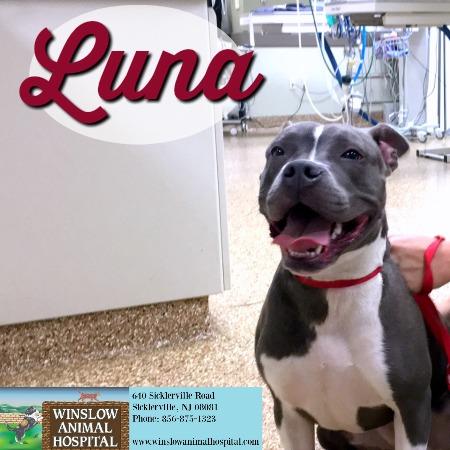
Luna’s Spay
Luna was here Monday for her spay procedure! Luna belongs to Jennifer, our Receptionist Team Leader. Luna is a sweet, friendly dog who loves to meet people. Although she was a little nervous that morning when she got to Winslow animal Hospital, she warmed up to our staff and was happy to greet them! Dr. Jen Chachkes performed the surgery toward the end of the day. Luna is recovering splendidly.
But why spay…?
Spay Procedures
All throughout the United States, there are homeless animals. There are an estimated 6-8 million homeless animals entering animal shelters every year. About half of these animals are adopted, but the other half are euthanized. These are healthy, sweet pets who would have made great companions.

There are hundreds of thousands of homeless animals euthanized in animal shelters in some states. These are not just offspring of homeless animals roaming neighborhoods. These are the puppies and kittens of family pets that were not spayed or neutered. Spaying or neutering pets reduces the number of pets euthanized in shelters or suffering in the streets, as well as providing health benefits to the pet that is spayed or neutered.
There are other benefits
- Your female pet will live a longer, healthier life.
- Spaying your female companion helps prevent uterine infections and mammary gland tumors, which can be fatal in about 50 percent of dogs and 90 percent of cats. Spaying your pet before her first heat offers the best protection from these diseases. Spaying your female pet eliminates unwanted litters.
- Your spayed female won’t go into heat.
While cycles can vary, female felines usually go into heat four to five days every three weeks during breeding season. In an effort to advertise for mates, they’ll yowl and urinate more frequently—sometimes all over the house! - It is highly cost-effective.
The cost of your pet’s spay surgery is a lot less than the cost of having and caring for a litter. It also beats the cost of treatment when your unneutered pet escapes and gets into fights, or worse, gets hit by a car as they cross the street! A spay reduces these roaming behaviors. Avoiding these problems means less costly vet bills for their owners. - Spaying or neutering will NOT make your pet overweight.
There is a myth that spaying or neutering will make a pet overweight. Lack of exercise and overfeeding will cause your pet to pack on the extra pounds—not neutering. Your pet will remain fit and trim as long as you keep their energy balance by continue to provide exercise and monitor food intake. - Spaying and neutering your pet is good for the community.
Stray animals pose a real problem in many parts of the country. They can prey on wildlife, potentially altering the local ecologic balance. Spaying and neutering is the strongest method we have in reducing the number of animals on the streets. - Spaying and neutering helps fight pet overpopulation.
Every year, an estimated 3-4 million cats and dogs of all ages and breeds are euthanized in shelters. Countless others suffer as strays. These high numbers are the result of unplanned litters that could have been prevented by spaying or neutering.
